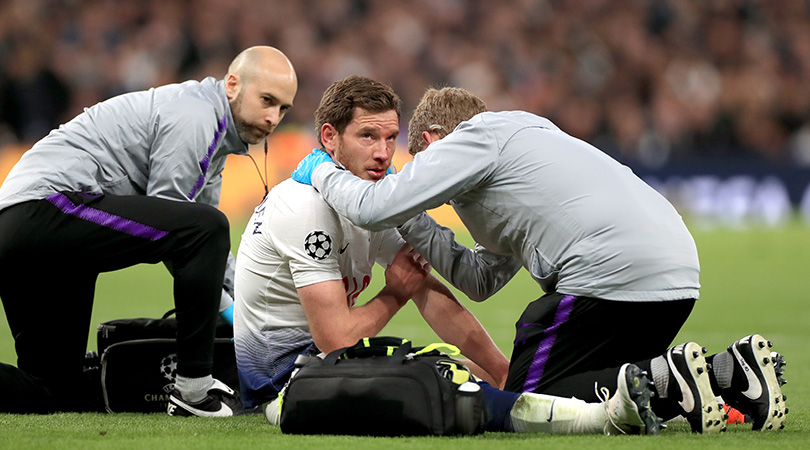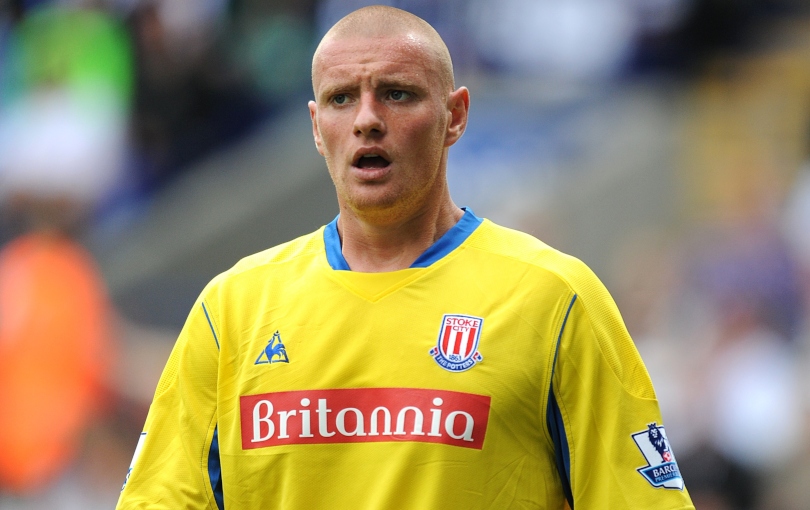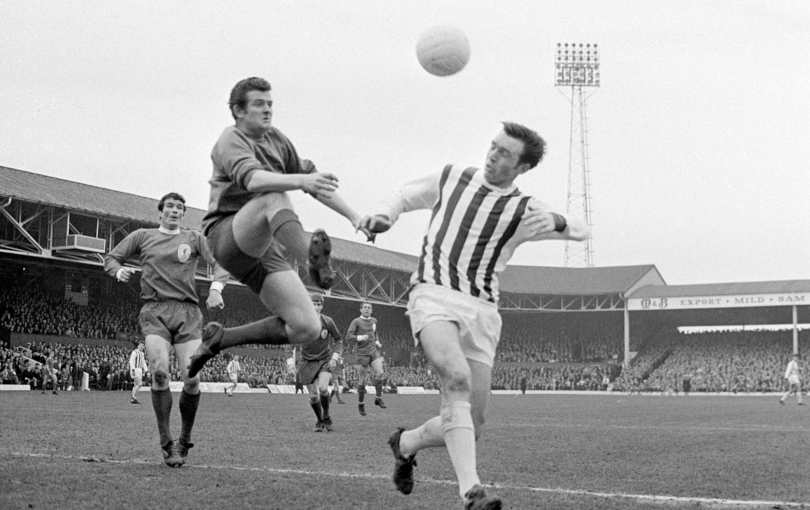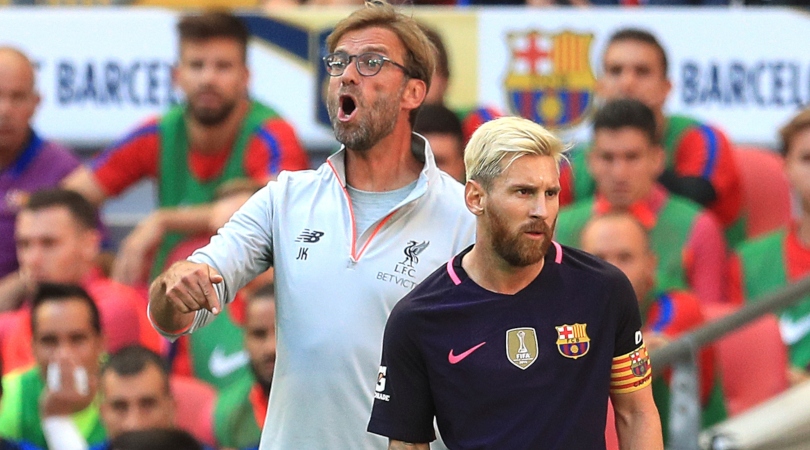
This feature originally appeared in the April 2019 issue of FourFourTwo. Subscribe today! 5 issues for £5
The sight in Andy Wilkinson’s right eye flickered and faded like a broken car headlight. A volley had struck the Stoke City defender flush on the temple from close range and blurred his senses. “It was scary, but I thought I’d be able to run it off,” he says to FFT.
The right-back had a point to prove. He was out of favour but had been handed a recall for the Potters’ FA Cup fifth round tie with Blackburn Rovers and was determined to take his chance. “I didn’t tell anyone I felt unwell, I tried to hide it, but then I was sick as I left the pitch,” he recalls.
Wilkinson was substituted at half-time. Medical staff realised he was suffering from classic symptoms of concussion: a traumatic brain injury, which occurs when a jolt to the head or body causes the brain to move rapidly back and forth inside the skull.
He was convinced it was nothing a tough defender couldn’t shrug off - after all, what harm could a lightweight modern football do? “I thought I’d be back in training on Monday morning, but as the days passed by I realised how serious my injury was,” he adds.
The 32-year-old began to suffer with vertigo - spells of prolonged dizziness which routinely saw rooms appear to spin in front of his eyes - balance problems, and regular bouts of nausea. The damage to his brain, coupled with his struggle to come to terms with the setback, also saw him develop anger issues and feelings of depression.
Wilkinson flew to America three times to undergo treatment from concussion experts, but he soon found there was no magic cure for his ills. “They told me very early on it was highly unlikely I’d play football again, because the risk of another brain injury was just too great.”
The best features, fun and footballing quizzes, straight to your inbox every week.
In February 2016, 12 months after his injury, Wilkinson was forced to retire. It was a blow even harder than the one that nearly rendered him unconscious. When he falls asleep at night, he often still dreams he plays football for a living, but reality hits home when he wakes up.
“The specialists I’ve seen don’t know if I’ll ever fully recover,” he says. “My depth perception – where I think I am in relation to objects – isn’t right. My peripheral vision is still distorted and I have to do vision therapy every day. I’ve got special lenses which help with the symptoms.”
Wilkinson’s story wouldn’t be out of place in a bygone era when footballers complained of headaches after heading soaking wet leather footballs for 90 minutes. However, scientists now believe modern balls – which travel faster through the air – could leave players equally at risk of suffering concussion and long-term brain injuries.

The everyday issue
A machine fires 20 footballs, one after another, towards a player stood inside a penalty area. The contraption simulates the pace and power of a typical corner-kick - but this isn’t a normal training session. Twenty-three players’ brains are being tested before and after the practice. They undergo the same tests for the following two days and again two weeks later.
Researchers at the University of Stirling carried out the study last October to reveal the impact of heading footballs on the brain. The results showed immediate changes in brain function after just a single session. Players performed between 41% and 67% worse in memory tests. A build up of chemicals was also found on their grey matter, which can make muscles more difficult to control.
The effects of the session lasted just 24 hours, but lead researcher, Dr Magdalena Leswaart, said the findings were cause for concern. She said: “Although the changes were temporary, we believe they were significant to brain health, particularly if they happen over and over again, as they do in football heading.”
A further study published in February by the Albert Einstein College of Medicine in New York, surveyed 222 adult amateur footballers who played for at least six months of the year. Players completed questionnaires to see how often they headed the ball and were involved in collisions. The results were again startling.
“We found that heading the ball is indeed related to concussion symptons,” said lead researcher Dr Michael Lipton. “This is contrary to previous studies, which have suggested collisions are most responsible for concussions. The findings raise concerns about the long-term effects of heading the ball – more research is needed.”
The tragic case of Jeff Astle is a warning from the past. He spent his final days wearing an adult nappy and drinking water out of a baby beaker. The former West Brom and England striker didn’t recognise his family and died unaware he’d ever been a footballer, despite being surrounded by pictures of his finest moments, medals and international caps at his family home.
“Everything that football gave him, it took away,” Astle’s daughter, Dawn, tells FFT. He died in January 2002, aged 59, after a four-year battle with what was believed to be Alzheimer’s disease. However, Dawn was convinced there was a link between her father’s condition and the number of blows he took to the head from heading a ball during his career.
A coroner agreed with her. Andrew Haigh, who delivered the verdict, ruled that Astle had died of an ‘industrial disease’ caused by repeated contact with the heavy leather ball used in the 1960s. He said it had caused a level of trauma similar to that suffered by a boxer at the end of a career spent absorbing the punches of heavy-handed opponents in the ring.
However, the diagnosis wasn’t entirely correct. In 2014, Dr Willie Stewart was granted permission by Astle’s family to carry out a re-examination of his brain. He found that he had in fact died of a condition known as CTE – a degenerative brain disease that can only be definitively diagnosed in post-mortem and one normally associated with boxers and American football players who have suffered multiple concussions.
A problem of the past?
But is it possible that heading a lightweight modern ball could have the same deadly impact over a number of years as the leather version Astle once compared to ‘a bag of bricks?’ It’s a question Eric Nauman, a professor of mechanical engineering at the University of Purdue in America and Larry Leverenz, clinical professor of health and kinesiology at the same school, have sought to find out.
The pair have spent the last eight years studying concussion in women’s soccer and American football. In 2015, they tracked two female high school teams over the course of one season. Players wore a sensor called an xPatch behind their right ears during every training session and game, to monitor the G-force of every blow to the head over 20g and how the brain moved within the skull after each hit. They also recorded which types of impact caused the most force and took MRI scans before, during and after the season, to track changes in the brain.
They were taken aback by the results, with the force from heading goal-kicks and long balls far higher than expected. “Many of them were between 50g and 100g, which is the same as a punch thrown by a boxer or a collision in American football,” Nauman says to FFT. “They also suffered these blows on average, 4.29 times per game. We don’t have the data yet, but it would be fair to estimate heading a goal-kick from a Premier League keeper could easily be 100g or more.”
At the end of the season, the players performed two memory tests. The first required them to recall an image they had just seen, while the second asked them to remember the previous two images. “The brains of the players who had taken the greatest number of hits had to work so much harder at both tests than those who had suffered the fewest hits,” says Leverenz. “The differences terrified us.”
A hidden killer
Interestingly, although scans showed changes in the function of half the players’ brains, none of them showed any symptoms of concussion. “If you bruise a different part of your body like your leg, you feel soreness and so you rest,” says Nauman. “But the brain doesn’t have the same pain receptors to tell you its hurt and to ease off, so you keep playing, heading the ball and accumulating damage.”
Nauman says smaller, repeated blows over a prolonged period of time can often be more serious than a single heavy collision. “If you look at an MRI scan of a brain that has taken lots of sub-concussive hits, it can look a lot worse than a scan of a player who has taken one big hit. If a player heads the ball regularly for 15 minutes, he’s absorbing a lot of force and so it won’t take a huge hit to knock him out.
“If you look over a longer period of time, let’s say you head the ball every day for six months, what happens is that your brain stays inflamed the entire time. If you have inflammation in the brain, it’s very different to other muscles in the body. Blood doesn’t clot like it does in skeletal muscle, so it takes longer to recover. If you don’t rest, there’s a definite risk of long-term damage.”
Nauman and Leverenz are keen to perform the same tests on Premier League players - but their ambitions have been met by a stumbling block. “We haven’t tested these guys yet because the Premier League and FIFA aren’t funding it,” says Nauman. “We could do this study for the fraction of a cost of one player. We could get all the answers in one study and then protect players’ long-term brain health.”
Not-so-rapid response
Dawn Astle has been calling for the FA to invest money in further research since her father’s death in 2002. She wants the governing body to fund a study to find out whether there is a link between concussion caused by heading footballs and long-term brain injury. “We need to know whether there is a higher rate of dementia in former players than the average population,” she says.
She launched the Jeff Astle Foundation in 2015 to raise awareness of brain injury in sport and has since been contacted by ‘hundreds and hundreds’ of ex-footballers suffering with symptons of dementia. “Four of England’s 1966 World Cup team now have dementia,” she says. “Five of Aston Villa’s 1957 FA Cup winning side from died of the disease. That ratio is far too high.”

In 2002, the FA promised to launch a joint study alongside the PFA, which failed to materialise. “It’s 15 years since my father died, but we’re still no further down the line,” Astle laments. “The FA have a duty of care across all levels of the sport. They don’t want to hear that football could be a killer because they want to promote the sport, but people are dying. Current players need to know the risks.”
The FA’s lack of action has similarities to the NFL’s initial stance in relation to American football’s own concussion epidemic. Back in 2002, Nigerian pathologist Bennet Omalu discovered the disease CTE – the same one found to have ravaged Astle’s brain – was devastating former players. His autopsy on former Pittsburgh Steelers centre, Mike Webster, found that repeated blows to his head during his career had caused him to fall victim to the condition.
However, the NFL disputed the findings before mounting scientific evidence, court hearings and a lawsuit by former players forced the league to acknowledge the crisis and agree a settlement, which could cost them $1bn over the next 65 years. Could the FA’s lack of action be in fear of similar financial repercussions?
“None of the families I’ve spoken to have ever mentioned money,” says Astle. “But football is frightened of what it is going to find out.”
America leads the way
In the US, new rules have been brought in to protect young players and could provide a vision of football’s future. In November 2015, the United States Soccer Federation introduced restrictions, which are mandatory for all youth national teams and academies. They prohibit players aged 10 or younger from heading during training or games. Youngsters aged between 11 and 13 are allowed to head the ball in matches but can’t exceed a maximum of 30 minutes aerial training per week. The number of headers per session is capped at 20 per player.
“A lot of the data out there at the moment relates to adult football,” the USA men’s team doctor, George Chiampas, tells FFT. “There isn’t a lot of research regarding youth football, but from the studies we’ve seen, it seems to make sense to protect younger players, whose brains are still developing and could be more vulnerable to damage from heading footballs.”
As it stands, the USA are the only one of FIFA’s 211 nations to have put such measures in place. PFA chairman Graham Taylor is keen for England follow suit. “I’d like to see it happen because it would bring much needed focus on the issue of concussion in English football,” he tells FFT. “We’ve been talking to the Football Association about this matter but they’re yet to act on it.”
Professor Antonio Belli is one of five experts who sit on the FA’s independent head injury panel. The group have put together new guidelines to advise clubs and players on the best practice when players suffer concussions during games, but the dangers of heading modern footballs still don’t appear to be a priority. “There’s a lot of anecdotal evidence out there, but I still don’t think there is any firm data to prompt these changes,” he says to FFT.
News of the developments in the US have been welcomed by Astle, but she stops short of calling for heading to be outlawed in the professional game. “We’ve never said we want it banned, dad wouldn’t want that, but the key is informed choice. If you go into a shop and buy a packet of cigarettes, you know the health risks. Not every player who heads a football for 15 years will get dementia, but with one simple study we can inform players of the risks.”
Technology could offer a simple alternative to sweeping rule changes. Nauman believes it would be easy to design a relatively inexpensive piece of headgear to protect players from the effects of heading footballs. “It’s a very fixable problem,” he says. “We could easily design a lightweight piece of protective gear for outfield players that would absorb 90% of the energy from headers.”
Wilkinson believes English football could learn a lot from American sport. “When I had treatment over there I saw the technology they’re using across many different sports,” he says. “If a player wears a piece of technology and can’t identify certain images, they’re told they shouldn’t be in the game any longer.” In the US, at least, the game is heading in the right direction.
NOW READ...
QUIZ Can you name all 30 Champions League semi-finalists since 1994?
LISTEN FourFourTwo Podcast, Episode #3: North London love-in
Subscribe to FourFourTwo today! 5 issues for £5
While you're here, why not take advantage of our brilliant new subscribers' offer? Get 5 copies of the world's greatest football magazine for just £5 – the game's greatest stories and finest journalism direct to your door for less than the cost of a London pint. Cheers!


